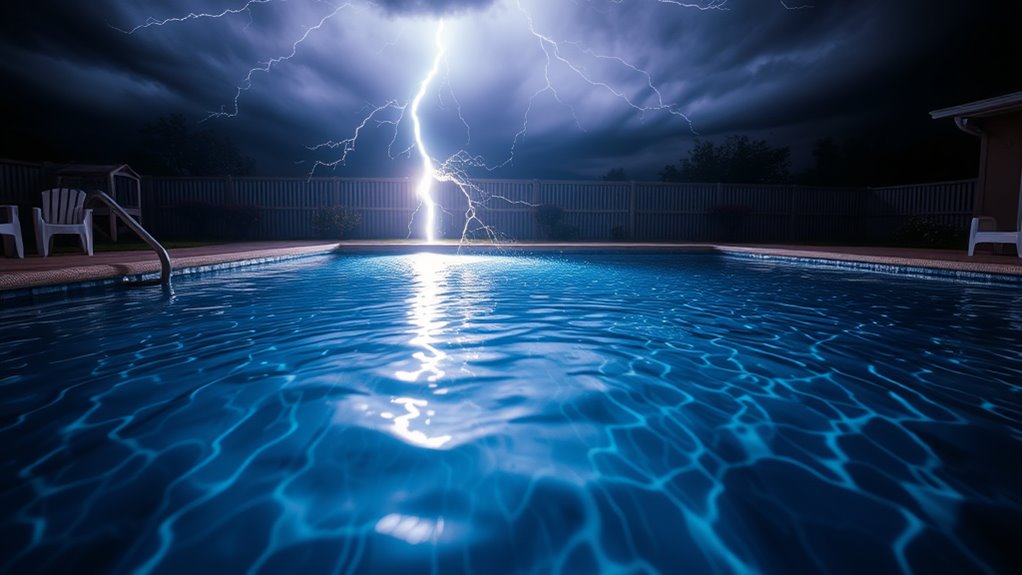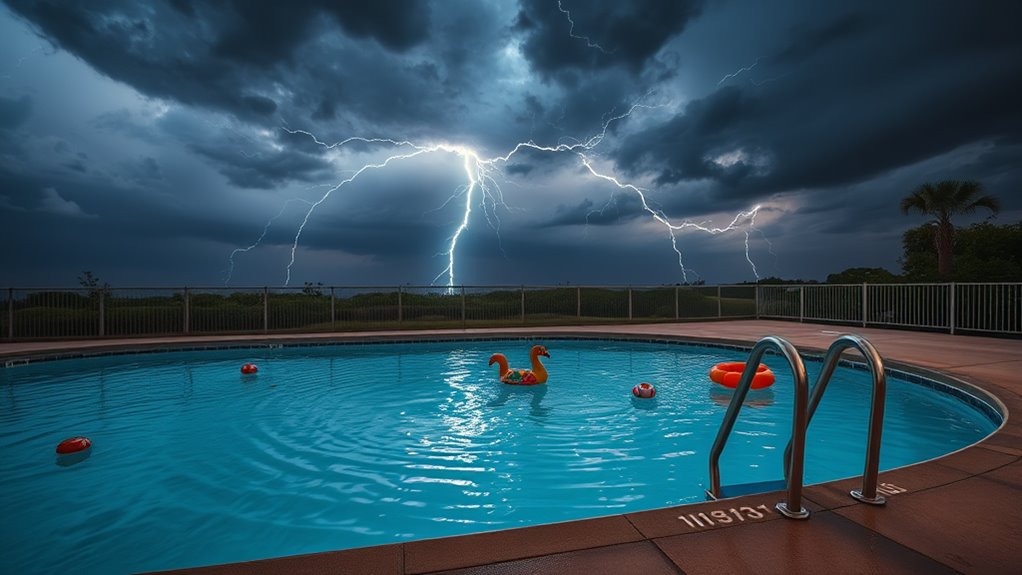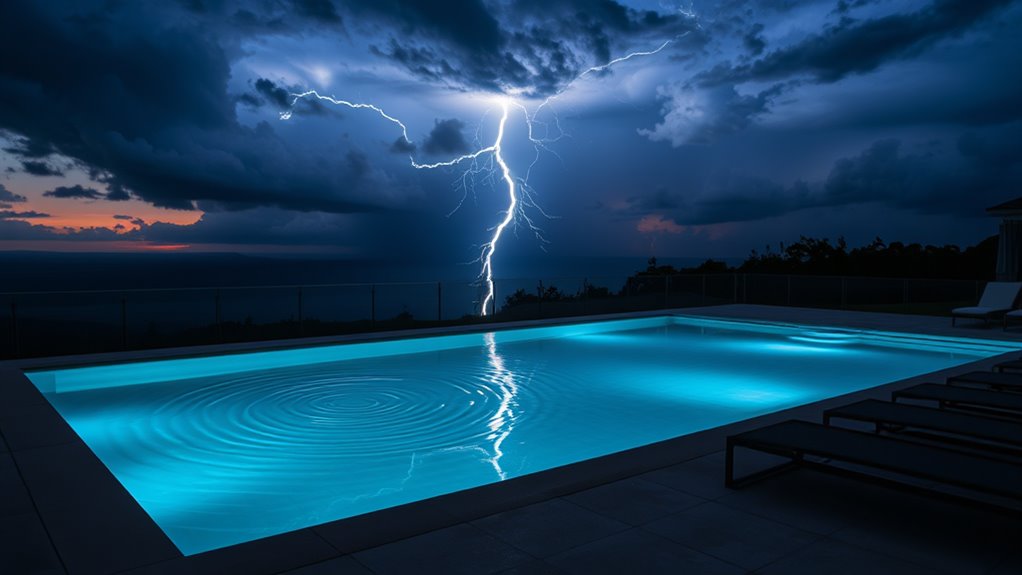Yes, lightning strikes in swimming pools have resulted in at least 12 documented fatalities between 1990-2022. You're actually 10 times more likely to be struck while swimming compared to dry ground, with water conducting electricity 20 times better than air. Lightning can spread electrical current up to 50 feet through pool water, affecting swimmers through both direct and indirect strikes. Understanding the science and safety protocols could make the difference between life and death.
The Science Behind Lightning and Water

When lightning strikes water, it disperses electrical current both horizontally and vertically, spreading approximately 20 feet in all directions from the point of impact. You'll find that water's high conductivity makes it particularly dangerous during electrical storms, as it can efficiently transmit deadly currents throughout the entire body of water.
Lightning frequency data shows that water-related strikes aren't rare occurrences. In fact, you're dealing with a phenomenon that occurs roughly 100 times per second worldwide. The electrical discharge from a typical lightning bolt carries about 300 million volts – enough to prove fatal even at considerable distances from the strike point. Since water conducts electricity 20 times better than air, you'll face markedly higher risks in an aquatic environment during a thunderstorm.
Historical Cases and Statistics
Several documented cases of lightning strikes in swimming pools have resulted in fatalities between 1990 and 2022, with the U.S. National Weather Service reporting at least 12 deaths during this period. You'll find that most historical incidents occurred in outdoor pools, though indoor facilities aren't completely safe either.
Safety regulations have evolved considerably since a notable 1994 incident in Florida, where three swimmers were killed by a single strike. Based on collected data, you're approximately 10 times more likely to be struck by lightning in a pool than on dry ground. The National Lightning Safety Council's statistics show that pool-related strikes account for about 2% of all lightning fatalities, though experts believe many cases go unreported. Modern building codes now require pools to have specific grounding systems and lightning protection measures.
Direct vs. Indirect Lightning Strikes in Pools

Although both types of lightning strikes pose serious risks to swimmers, direct and indirect strikes affect pools through distinctly different mechanisms. Direct strikes occur when lightning hits the water's surface, creating an immediate, concentrated discharge of electrical energy. You'll face the highest risk of electrocution within 20 feet of the strike point.
Indirect strikes, which are more common, happen when lightning hits nearby objects or the ground, allowing electrical current to travel through wet surfaces, metal fixtures, and plumbing connected to the pool. As part of essential swimming precautions, you should understand that water conducts electricity in all directions, spreading the charge across a wider area. Lightning awareness experts recommend exiting pools immediately when storms approach, as both strike types can deliver lethal amounts of electrical current through water.
Pool Safety Guidelines During Thunderstorms
Understanding the distinct risks of direct and indirect strikes leads us to specific safety protocols that can protect swimmers during thunderstorms.
For ideal lightning preparedness, you'll need to monitor weather conditions and act swiftly when storms approach. Follow these essential guidelines:
| Time Frame | Action Required | Storm Awareness Level |
|---|---|---|
| 30+ min before | Check weather apps | Low alert status |
| 20 min before | Clear pool area | Heightened warning |
| 10 min before | Secure equipment | High alert |
| During storm | Stay indoors | Maximum caution |
You shouldn't return to the pool until 30 minutes after the last thunder or lightning. Indoor facilities require similar precautions, as electrical current can travel through plumbing and ground channels. If you're managing a facility, verify your emergency protocols align with National Weather Service recommendations.
Understanding Electric Current Behavior in Water

When lightning strikes a body of water, the electrical current disperses outward in a radial pattern, creating a voltage gradient that decreases with distance from the point of impact. You'll find that water's electric conductivity varies based on several factors, including mineral content and water temperature. The warmer the water, the more efficiently it conducts electricity.
In a pool setting, you're particularly vulnerable because you're likely to be the tallest object in the water, making you a potential conductor. The current can enter your body through multiple contact points, affecting your heart, muscles, and nervous system. While concrete pools conduct electricity better than fiberglass ones, you're at risk in either type when lightning strikes nearby, as the current can travel through the water, pool equipment, and surrounding ground.
Pool Design and Lightning Protection Systems
Modern pool designs incorporate specific safety features that help minimize lightning-related risks. You'll find bonded rebar networks in concrete pool structures that create equipotential planes, reducing voltage differences across the pool's surface. These systems connect to proper grounding electrodes, directing electrical charges safely into the earth.
Your pool's lightning protection system should include air terminals (lightning rods) strategically placed around the pool area, connected to down conductors and grounding networks. These components work together to intercept lightning strikes and channel them away from swimmers. The National Fire Protection Association's NFPA 780 standard recommends maintaining a 20-foot clearance zone between pools and any tall objects that could attract lightning. You'll also need surge protection devices for pool equipment to prevent damage from indirect strikes.
Weather Warning Systems and Response Protocols
Modern pool lightning alert systems integrate real-time weather data and National Weather Service warnings to notify you of approaching electrical storms within a 10-mile radius. You'll need to initiate your facility's emergency protocols when lightning is detected within 6 miles, including immediate pool evacuation and activation of audio-visual warning signals. Your evacuation guidelines should direct swimmers to indoor shelter, avoiding contact with metal objects and electrical equipment until the all-clear signal is issued, typically 30 minutes after the last lightning detection.
Pool Lightning Alert Systems
Reliable lightning alert systems serve as critical safety infrastructure for pool facilities, incorporating multiple detection methods to provide early warnings of approaching electrical storms. You'll find these systems utilizing advanced technology to monitor atmospheric conditions within a 10-mile radius of your facility.
Modern pool alert systems combine several detection methods for maximum safety:
- Ground-based sensors that detect electromagnetic pulses from lightning strikes
- Real-time weather data integration from national weather services
- Cloud-to-ground lightning detection networks with GPS positioning
- Mobile app notifications that sync with facility warning systems
- Automated horn and strobe light warning systems
When your facility's lightning detection system activates, it'll trigger an evacuation protocol, giving you and your staff sufficient time to clear the pool area before dangerous conditions develop. These systems typically provide a minimum 30-minute safety margin.
Emergency Evacuation Guidelines
When thunder roars or lightning detection systems trigger an alert, implementing a rapid and organized pool evacuation becomes paramount for facility safety. You'll need to clear the pool immediately and direct swimmers to designated indoor shelters at least 40 feet from windows and doors.
Your facility should establish clearly marked evacuation routes and conduct regular emergency drills to guarantee everyone knows the proper procedures. You must wait a minimum of 30 minutes after the last thunder or lightning detection before allowing swimmers to re-enter the pool area. During this time, you'll need to monitor weather conditions using multiple sources, including your facility's lightning detection system and local weather services. Train your staff to recognize the signs of approaching storms and to execute evacuation protocols without hesitation.
Safety Myths vs. Reality: What Swimmers Need to Know
You'll face considerably higher risks of lightning-related injuries in outdoor pools compared to indoor facilities, with the National Weather Service reporting that water-related activities account for 14% of lightning fatalities. Indoor pools provide better protection due to their structural safeguards and grounding systems, though you'll still need to exit the water immediately when storms approach. You'll need to understand that contrary to popular myths, lightning can strike indoor pools through plumbing and electrical systems, making it essential to follow your facility's emergency protocols regardless of pool location.
Lightning Risk While Swimming
Contrary to popular belief, swimming pools don't attract lightning strikes more frequently than other outdoor locations. However, water's conductive properties make lightning strikes particularly dangerous for swimmers. For best swimming safety and lightning awareness, you'll need to understand the specific risks.
Key factors that increase your risk during thunderstorms:
- Electrical current can spread up to 50 feet through water from a strike point
- Your raised position in water makes you a potential conductor
- Pool equipment and metal components can carry secondary currents
- Chemical treatments in pool water increase conductivity
- Lightning can strike up to 10 miles away from a storm's center
You should exit the pool immediately when thunder is heard or lightning is visible, and wait 30 minutes after the last thunderclap before returning to swimming activities.
Indoor vs. Outdoor Pools
While indoor pools offer considerably more protection from lightning strikes than outdoor pools, neither environment is completely risk-free. Indoor advantages include the building's structural protection and integrated grounding systems, which greatly reduce the likelihood of a direct strike affecting swimmers. The concrete and steel framework typically acts as a Faraday cage, directing electrical charges around rather than through the structure.
Outdoor risks are substantially higher due to direct exposure to strikes and ground current spread. You're vulnerable to both direct hits and side strikes when swimming outdoors, especially since water conducts electricity efficiently. Metal components like ladders, handrails, and filtration systems can also channel electrical current. During thunderstorms, it's essential to exit any pool immediately and seek proper shelter, regardless of whether you're swimming indoors or outdoors.
Emergency Response Protocols
Several dangerous myths persist about emergency responses to lightning near swimming pools. You'll need to follow established safety protocols rather than relying on outdated beliefs. Emergency drills and response training are essential components of any pool facility's lightning safety plan.
- Exit the water immediately when thunder is heard, even if lightning isn't visible
- Move indoors to a substantial building, not a pool house or picnic shelter
- Wait 30 minutes after the last thunder before returning to the pool
- Call emergency services immediately if someone is struck by lightning
- Perform CPR if needed, as lightning victims don't carry an electrical charge
Following these evidence-based protocols can mean the difference between life and death. Proper response training guarantees lifeguards and staff can execute these procedures efficiently during weather emergencies.
Frequently Asked Questions
Can Pool Chemicals Affect How Dangerous Lightning Strikes Are in Water?
Pool chemicals can influence lightning conductivity in water. When you add chlorine, salt, or other chemicals to your pool, you're increasing its electrical conductivity by introducing more ions into the solution. The higher concentration of dissolved substances makes the water more conductive, potentially making lightning strikes more dangerous. However, you'll face severe risks from a lightning strike regardless of the chemical composition of the water.
Do Indoor Swimming Pools Pose the Same Lightning Risks as Outdoor Pools?
You're markedly safer in an indoor pool during a thunderstorm due to proper electrical grounding and structural protection. Indoor pools are typically shielded by buildings constructed with lightning protection systems, including metal frameworks and grounding rods. However, you should still exercise caution if the pool's plumbing connects to outdoor systems. Modern indoor pool facilities follow strict safety codes that minimize electrical risks during storms, making them considerably safer than outdoor alternatives.
How Long After a Lightning Strike Is It Safe to Re-Enter?
Following proper safety procedures, you should wait at least 30 minutes after the last observed lightning strike before re-entering any outdoor area. This "30-30 rule" is a standard lightning awareness protocol recommended by the National Weather Service. If you hear thunder again during this waiting period, you'll need to restart the 30-minute countdown. This timeframe allows for the storm cell to move sufficiently away from your location.
Are Inflatable Pools Safer Than In-Ground Pools During Thunderstorms?
You're not safer in an inflatable pool during a thunderstorm. While inflatable pools contain less water than in-ground pools, they still conduct electricity effectively. In fact, their raised position and metal frames can make them more susceptible to lightning strikes. For proper thunderstorm preparedness, you should exit any type of pool immediately when thunder is heard and seek shelter indoors. Water's conductive properties make all pools similarly dangerous during electrical storms.
Does Wearing Rubber Swim Gear Provide Any Protection Against Lightning Strikes?
You shouldn't rely on rubber swim gear for lightning protection. While rubber is typically an insulator, the thin rubber insulation found in swimming goggles, caps, or suits won't protect you from lightning's massive electrical charge (up to 300 million volts). When lightning strikes, it'll easily overcome any minimal resistance these materials provide. Water's high conductivity combined with lightning's power makes swim gear ineffective as a safety measure against strikes.



